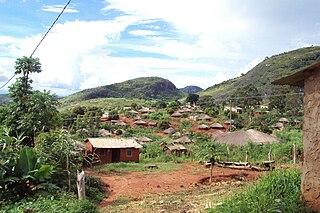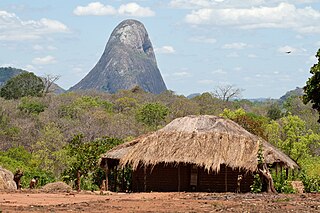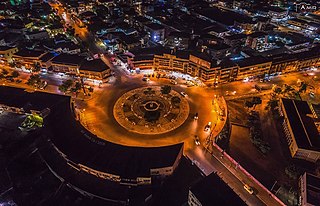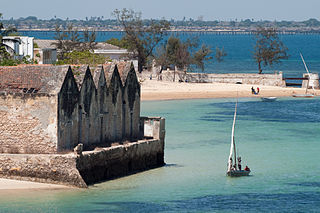
Mozambique, officially the Republic of Mozambique, is a country located in southeastern Africa bordered by the Indian Ocean to the east, Tanzania to the north, Malawi and Zambia to the northwest, Zimbabwe to the west, and Eswatini and South Africa to the southwest. The sovereign state is separated from the Comoros, Mayotte and Madagascar by the Mozambique Channel to the east. The capital and largest city is Maputo.

Portuguese Mozambique or Portuguese East Africa were the common terms by which Mozambique was designated during the period in which it was a Portuguese colony. Portuguese Mozambique originally constituted a string of Portuguese possessions along the south-east African coast, and later became a unified colony, which now forms the Republic of Mozambique.

Zambezia is the second most-populous province of Mozambique, located in the central coastal region south-west of Nampula Province and north-east of Sofala Province. It has a population of 5.11 million, according to the 2017 census. The provincial capital is Quelimane.

Nampula is a province of northern Mozambique. It has an area of 79,010 km2 (30,510 sq mi) and a population of 5,758,920, making it the most populous province in Mozambique. Nampula is the capital of the province.

Nampula is the capital city of Nampula Province in Northern Mozambique. With a population of 743,125, it is the third-largest city in Mozambique after Maputo and Matola. The city is located in the interior of Nampula Province, approximately 200 kilometers from the coast and is surrounded by plains and rocky outcrops. The city is a major regional centre for the entire Northern region of Mozambique, as well as parts of Central Mozambique and border areas of Malawi and Tanzania.

Beira is the capital and largest city of Sofala Province, where the Pungwe River meets the Indian Ocean, in the central region of Mozambique. It is the fourth-largest city by population in Mozambique, after Maputo, Matola and Nampula. Beira had a population of 397,368 in 1997, which grew to 530,604 in 2019. A coastal city, it holds the regionally significant Port of Beira, which acts as a gateway for both the central interior portion of the country as well as the land-locked nations of Zimbabwe, Zambia and Malawi.

Angoche Island is a small island in the district of same name in Mozambique. The island lies at the mouth of the Mluli River; the river enters the sea at the southernmost point of a large bay which contains a number of low, marshy islands. One of these islands was home to the ancient Islamic settlement of Angoche, and the island is thus known as Angoche Island.Being a coastal island its main source of income was the illegal shipment of slaves, which allowed for the enrichment of the aristocratic classes of the Nyapakho clan. It was not taken by the Portuguese until 1913, thanks to the brave resistance of the sultan, particularly Ibrahim Iussuf. His nephew, who was the commander-in-chief of a 30,000 men army took over power and opposed with tenacity the Portuguese until 1890. By then, Farlah, the last sultan resumed the war against the Portuguese until he was captured in a battle in 1910 and deported to East Timor where he died in prison. The small island is subject to cyclones; Cyclone Huda in particular is remembered, and so permanent habitation has not been possible. Angoche is the largest producer of cashew and shrimps in Mozambique.

The Island of Mozambique lies off northern Mozambique, between the Mozambique Channel and Mossuril Bay, and is part of Nampula Province. Prior to 1898, it was the capital of colonial Portuguese East Africa. With its rich history and sandy beaches, the Island of Mozambique is a UNESCO World Heritage Site and one of Mozambique's fastest-growing tourist destinations. It has a permanent population of approximately 14,000 people and is served by nearby Lumbo Airport on the Nampula mainland. The name of the country, Mozambique, is derived from the name of this island.

The Angoche Sultanate was established in 1485 along an archipelago off the Northern Mozambique coastline. Centered on the cities of Angoche and Moma, the Sultanate also had a number of vassal territories surrounding them. They were finally removed from power by the Portuguese colonial government in 1910.

Mozambique is a Christian majority country, with Islam being a minority faith practiced by around 17.5% of the population as of 2020. The faith was introduced by merchants visiting the Swahili coast, as the region was part of the trade network that spanned the Indian Ocean. This later led to the formation of several officially Muslim political entities in the region.

Verónica Nataniel Macamo Dlhovo is a Mozambican politician who has served as the Minister of Foreign Affairs since 2020. She served as the President of the Assembly of the Republic of Mozambique from 2010 to 2020. Dlhovo is a member of Frelimo.

Angoche District is a district of Nampula Province in north-eastern Mozambique, with limits in the north with Mogincual District, in the south with Larde District, to the east with the Indian Ocean and to the west with Mogovolas District. The principal town is Angoche. It is located 185 km from the provincial capital, Nampula City.

Intense Tropical Cyclone Jokwe was the first tropical cyclone to make landfall in Mozambique since Cyclone Favio struck in the previous year, and was the most recent cyclone to make landfall on Mozambique until Cyclone Dineo in 2017. The tenth named storm of the 2007–08 South-West Indian Ocean cyclone season, Jokwe was first classified as a tropical depression on 2 March over the open Southwest Indian Ocean. It tracked west-southwest, crossing northern Madagascar as a tropical storm on 5 March before intensifying into a tropical cyclone on 6 March. Jokwe rapidly intensified to reach peak winds of 195 km/h (121 mph), before weakening slightly and striking Nampula Province in northeastern Mozambique. It quickly weakened while paralleling the coastline, though the storm restrengthened as it turned southward in the Mozambique Channel. Late in its duration, it remained nearly stationary for several days, and steadily weakened due to wind shear before dissipating on 16 March.

Filipe Jacinto Nyusi is a Mozambican politician serving since 2015 as the fourth President of Mozambique. He is the current leader of FRELIMO, the party that has governed Mozambique since its independence from Portugal in 1975. Additionally, he has served as the Chairman of the Southern African Development Community since August 2020. During his time in office, President Nyusi has promoted peace and security, and signed multiple agreements with the main opposition parties, RENAMO, to bring a definitive and lasting peace to Mozambique.
Nyungwe is a Bantu language of Mozambique. It is used as a trade language throughout Tete Province.
The following is a timeline of the history of the city of Beira, Mozambique.

Goa Island, locally known as Watólofu, also known as Saint George Island, is a small archetypal desert peninsula, with a flat rocky brown coral reef, outcrop with dense borderline vegetation, white sand beach and a lighthouse. It is surrounded by crystal clear water, home to a variety of tropical fishes. The island is uninhabited and located within Nampula Province in Mozambique. It is situated in the Indian Ocean near Mozambique Channel about 5 km (3.1 mi) east of Mozambique Island and is part of the archipelago with Island of Sena and Island of Mozambique.

Cristóvão Artur Chume is a Mozambican military general who has been the Minister of National Defense since his appointment in November 2021. He had previously served as the Commander of the Army Branch of the Mozambique Defence Armed Forces from March to November 2021.

Cervejas de Moçambique (CDM) is a Mozambican beer brewing group, subsidiary of Anheuser-Busch InBev, that holds all the major Mozambican beer brands and controls approximately 94% of the Mozambican beer market.
The 2023 Mozambican local elections were held on 11 October 2023 to elect mayors and municipal councils across the country. FRELIMO won 64 of the 65 municipalities contested, with the only city won by another party being Beira, which was won by the Democratic Movement of Mozambique. Tensions rose prior to the elections, with the police arresting members of the opposition in several cities. On October 27, after the election results came out, protests broke out in several major cities such as Nampula and Maputo in reaction to alleged fraud in the election.

















